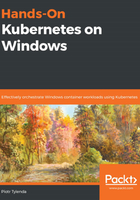
Creating Containers
The concepts of containers and OS-level virtualization have their roots in the chroot system call in Unix V7 operating systems (OSes), which date back to the late 1970s. Starting with a simple concept of process isolation and chroot jails, where the process is running in an apparently isolated root directory, containerization has undergone rapid evolution and became a mainstream technology in the 2010s with the advent of Linux Containers (LXC) and Docker. In 2014, Microsoft announced support for Docker Engine in the incoming release of Windows Server 2016. This is where the story of Windows containers and Kubernetes on Windows begins.
In this chapter, we will provide you with a better understanding of containers for the Windows OS by highlighting important differences between containerization on Linux and Windows and container runtime types on Windows, namely Windows Server Containers (or process isolation) and Hyper-V isolation. We will also learn how to install Docker Desktop for Windows 10 for development scenarios and create our first example container running on your machine.
This chapter will cover the following topics:
- Linux versus Windows containers
- Understanding Windows container variants
- Installing Docker Desktop for Windows tooling
- Building your first container